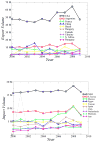Global maize trade and food security: implications from a social network model
- PMID: 23656551
- PMCID: PMC3762915
- DOI: 10.1111/risa.12064
Global maize trade and food security: implications from a social network model
Abstract
In this study, we developed a social network model of the global trade of maize: one of the most important food, feed, and industrial crops worldwide, and critical to food security. We used this model to analyze patterns of maize trade among nations, and to determine where vulnerabilities in food security might arise if maize availability was decreased due to factors such as diversion to nonfood uses, climatic factors, or plant diseases. Using data on imports and exports from the U.N. Commodity Trade Statistics Database for each year from 2000 to 2009 inclusive, we summarized statistics on volumes of maize trade between pairs of nations for 217 nations. There is evidence of market segregation among clusters of nations; with three prominent clusters representing Europe, Brazil and Argentina, and the United States. The United States is by far the largest exporter of maize worldwide, whereas Japan and the Republic of Korea are the largest maize importers. In particular, the star-shaped cluster of the network that represents U.S. maize trade to other nations indicates the potential for food security risks because of the lack of trade these other nations conduct with other maize exporters. If a scenario arose in which U.S. maize could not be exported in as large quantities, maize supplies in many nations could be jeopardized. We discuss this in the context of recent maize ethanol production and its attendant impacts on food prices elsewhere worldwide.
Keywords: Food security; global trade; maize; network models.
© 2013 Society for Risk Analysis.
Figures







Similar articles
-
Aflatoxin regulations in a network of global maize trade.PLoS One. 2012;7(9):e45151. doi: 10.1371/journal.pone.0045151. Epub 2012 Sep 25. PLoS One. 2012. PMID: 23049773 Free PMC article.
-
Assessing the impact of food trade centric on land, water, and food security in South Korea.J Environ Manage. 2023 Apr 15;332:117319. doi: 10.1016/j.jenvman.2023.117319. Epub 2023 Jan 31. J Environ Manage. 2023. PMID: 36731406
-
Shock transmission in the International Food Trade Network.PLoS One. 2018 Aug 8;13(8):e0200639. doi: 10.1371/journal.pone.0200639. eCollection 2018. PLoS One. 2018. PMID: 30089103 Free PMC article.
-
Transgenic maize event TC1507: Global status of food, feed, and environmental safety.GM Crops Food. 2015;6(2):80-102. doi: 10.1080/21645698.2015.1054093. GM Crops Food. 2015. PMID: 26018138 Free PMC article. Review.
-
First generation biofuels compete.N Biotechnol. 2010 Nov 30;27(5):596-608. doi: 10.1016/j.nbt.2010.06.010. Epub 2010 Jun 25. N Biotechnol. 2010. PMID: 20601265 Review.
Cited by
-
Robustness and efficiency of international pesticide trade networks subject to link removal strategies.Sci Rep. 2022 Nov 16;12(1):19641. doi: 10.1038/s41598-022-21777-1. Sci Rep. 2022. PMID: 36385189 Free PMC article.
-
Plasticity QTLs specifically contribute to the genotype × water availability interaction in maize.Theor Appl Genet. 2023 Oct 19;136(11):228. doi: 10.1007/s00122-023-04458-z. Theor Appl Genet. 2023. PMID: 37855950
-
Risk of Global External Cereals Supply under the Background of the COVID-19 Pandemic: Based on the Perspective of Trade Network.Foods. 2021 May 23;10(6):1168. doi: 10.3390/foods10061168. Foods. 2021. PMID: 34071044 Free PMC article.
-
Population Genomics Provide Insights into the Global Genetic Structure of Colletotrichum graminicola, the Causal Agent of Maize Anthracnose.mBio. 2023 Feb 28;14(1):e0287822. doi: 10.1128/mbio.02878-22. Epub 2022 Dec 19. mBio. 2023. PMID: 36533926 Free PMC article.
-
Identification and Analysis of Zinc Efficiency-Associated Loci in Maize.Front Plant Sci. 2021 Nov 15;12:739282. doi: 10.3389/fpls.2021.739282. eCollection 2021. Front Plant Sci. 2021. PMID: 34868123 Free PMC article.
References
-
- Godfray HC, Pretty J, Thomas SM, Warham EJ, Beddington JR. Global food supply: Linking policy on climate and food. Science. 2011;331:1013–4. - PubMed
-
- Gomez MI, Barrett CB, Buck LE, DeGroote H, Ferris S, Gao HO, McCullough E, Miller DD, Outhred H, Pell AN, Reardon T, Refnanestri M, Ruben R, Struebi P, Swinnen J, Toesnard MA, Weinberger K, Keatinge JD, Milstein MB, Yang RY. Agriculture: Research principles for developing country food value chains. Science. 2011;332:1154–5. - PubMed
-
- Foley JA, Ramankutty N, Brauman KA, Cassidy ES, Gerber JS, Johnston M, Mueller ND, O’Connell C, Ray DK, West PC, Balzer C, Bennett EM, Carpenter SR, Hill J, Monfreda C, Polasky S, Rockstrom J, Sheehan J, Siebert S, Tilman D, Zaks DP. Solutions for a cultivated planet. Nature. 2011;478:337–42. - PubMed
-
- Romm J. Desertification: The next dust bowl. Nature. 2011;478:450–1. - PubMed
-
- FAO (Food and Agriculture Organization) Maize in Human Nutrition. Rome, Italy: Food and Agriculture Organization of the United Nations; 1992.
Publication types
MeSH terms
Grants and funding
LinkOut - more resources
Full Text Sources
Other Literature Sources

